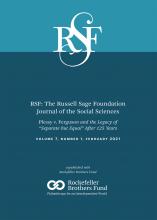Research Article
Open Access
Confronting the Legacy of “Separate but Equal”: Can the History of Race, Real Estate, and Discrimination Engage and Inform Contemporary Policy?
Jason Reece
RSF: The Russell Sage Foundation Journal of the Social Sciences February 2021, 7 (1) 110-133; DOI: https://doi.org/10.7758/RSF.2021.7.1.07
Jason Reece
aAssistant professor of city and regional planning at the Knowlton School, Ohio State University, United States

REFERENCES
- ↵
- Acevedo-Garcia, Dolores,
- Nancy McArdle,
- Erin F. Hardy,
- Unda Ioana Crisan,
- Bethany Romano,
- David Norris,
- Mikyung Baek, and
- Jason Reece
- ↵
- Acevedo-Garcia, Dolores,
- Clemens Noelke,
- Nancy McArdle,
- Nomi Sofer,
- Nick Huntington,
- Erin Hardy,
- Rebecca Huber,
- Mikyung Baek, and
- Jason Reece
- ↵
- Acs, Gregory,
- Rolf Pendall,
- Mark Treskon, and
- Amy Khare
- ↵
- Beck, Andrew F.,
- Erika M. Edwards,
- Jeffrey D. Horbar,
- Elizabeth A. Howell,
- Marie C. McCormick, and
- DeWayne M. Pursley
- ↵
- Bell, Derrick A., Jr.
- ↵
- ↵
- Brown University
- ↵
- Cashin, Sheryll
- ↵
- Chetty, Raj,
- Nathaniel Hendren, and
- Lawrence F. Katz
- ↵
- ↵
- Coates, Ta-Nehisi
- ↵
- Conley, Dalton
- ↵
- Delgado, Richard, and
- Jean Stefancic
- ↵
- Dettling, Lisa J.,
- Joanne W. Hsu,
- Lindsay Jacobs,
- Kevin B. Moore, and
- Jeffrey P. Thompson
- ↵
- DiAngelo, Robin
- ↵
- ↵
- Franklin County
- ↵
- Frey, William H
- ↵
- ↵
- Grant-Thomas, Andrew, and
- john a. powell
- ↵
- Health Improvement Partnership Cuyahoga
- ↵
- Hernandez, Jesus
- Huggins, John C
- ↵
- Jacobs, Gregory S
- ↵
- ↵
- Kneebone, Elizabeth, and
- Natalie Holmes
- Lipsitz, George
- ↵
- Logan, John R., and
- Brian J. Stults
- ↵
- Lu, Michael C., and
- Belinda Chen
- ↵
- Lu, Michael C., and
- Neal Halfon
- ↵
- Luxenberg, Steve
- ↵
- Kothari, Catherine L.,
- Rajib Paul,
- Ben Dormitorio,
- Fernando Ospina,
- Arthur James,
- Deb Lenz,
- Kathleen M. Baker,
- Amy B. Curtis, and
- James Allen Wiley
- ↵
- Manning-Thomas, June
- ↵
- ↵
- McClure, Elizabeth,
- Lydia Feinstein,
- Evette Cordoba,
- Christian Douglas,
- Michael Emch,
- Whitney Robinson,
- Sandro Galea, and
- Allison E. Aiello
- ↵
- Nightingale, Carl H
- ↵
- powell, john a
- ↵
- Reece, Jason
- ↵
- Reece, Jason, and
- Meghan Z. Gough
- ↵
- Reece, Jason,
- Matt Martin,
- Joshua Bates,
- Amanda Golden,
- Kelsey Mailman, and
- Ronni Nimps
- ↵
- Rothstein, Richard
- ↵
- Rugh, Jacob S., and
- Douglas S. Massey
- ↵
- Rusk, David
- ↵
- Shapiro, Thomas M
- ↵
- Stephens, Alexis
- ↵
- Sullivan, Shannon
- Thomas, J. M
- ↵
- ↵
- ↵
- Wise, Tim
In this issue
Confronting the Legacy of “Separate but Equal”: Can the History of Race, Real Estate, and Discrimination Engage and Inform Contemporary Policy?
Jason Reece
RSF: The Russell Sage Foundation Journal of the Social Sciences Feb 2021, 7 (1) 110-133; DOI: 10.7758/RSF.2021.7.1.07
Jump to section
Related Articles
- No related articles found.
Cited By...
- No citing articles found.





